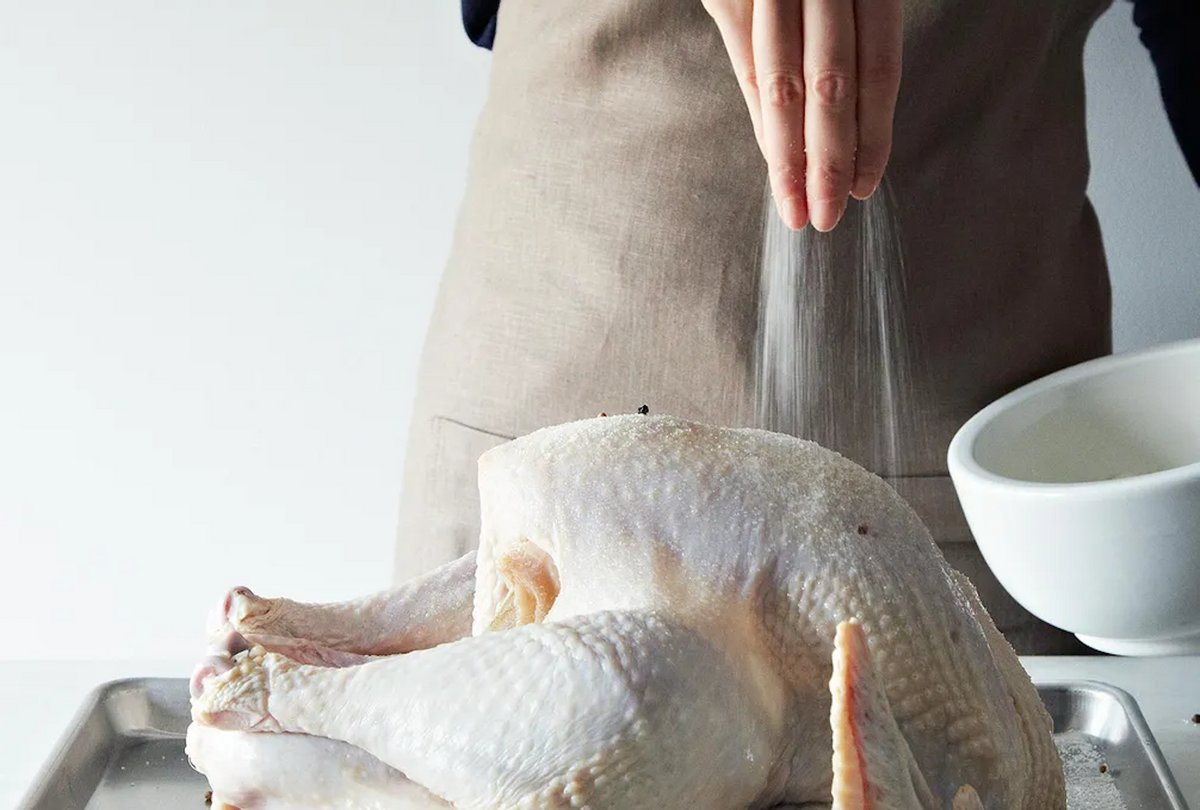There's nothing worse than bland turkey on Thanksgiving. There, we said it. The antidote to blandness? Salt, of course.
It seems obvious, but whether you go the route of fancy compound butters and fresh herbs and citrus and spices — which are all lovely ways to make your turkey, well, yours — the only molecules small enough to actually penetrate the meat of the bird is salt. As The Food Lab's J. Kenji López-Alt says, "Most . . . flavorful molecules are organic compounds that are relatively large in size — on a molecular scale, that is — while salt molecules are quite small. So, while salt can easily pass across the semipermeable membranes that make up the cells in animal tissue, larger molecules cannot." So what does all of this mean for home cooks? Well, it's not as easy to add flavor to a Thanksgiving turkey as you may expect (if you've ever cooked turkey for Thanksgiving, then you already know this to be true).
There are a few ways to achieve a well-seasoned (i.e., well-salted) bird — and one thing you should never do:
How to season a turkey
There are three ways to season a turkey, the first of which is the easiest method. No advance prep work needed, no specialty tools. As soon as the turkey has come to room temperature, season it with salt, pepper, a little bit of melted butter, and any other dried herbs or spices that you please. Easy, right? But if you want to up your turkey game this year, try your hand at a wet brine or dry brine.
1. Just season it!
I've written in detail exactly how I like to cook a turkey, which involves little more than unsalted softened butter, kosher salt, and freshly ground black pepper. Kind of like a roast chicken. Actually, exactly like a roast chicken. Go very heavy on the salt all over the bird (it can take it). Making sure to really season the inner cavity as well (especially where the breast is) ensures that the meat will be well-salted from all sides.
Or do what Test Kitchen Director Josh Cohen does: Don't season your turkey until after it cooks. (Yep, you heard him.)
"Rub the outside of the turkey with canola oil before it goes in the oven for an extra golden skin," he advises. "Don't worry about seasoning the turkey with salt before it goes into the oven; the seasoning will happen later. Add a pinch or two of salt and a small squirt of olive oil to the sliced turkey breast and thigh meat while it's still warm. Pour some of the drippings over, too. Toss the meat with the salt, olive oil, and drippings. Taste and add more salt as necessary. You will have achieved turkey nirvana with little-to-no effort."
2. How to dry-brine turkey
"I dry-brine my turkey a day or a few days before if I can swing it and baste with a mixture of butter and olive oil," Food Stylist Anna Billingskog tells me. "Sometimes I throw some herbs and spices like thyme in the basting butter/oil mix, or smoked paprika. The paprika helps with color, but also flavors the skin in a nice way." Try adding other dry spices like garlic powder to the seasoning blend, or even maple syrup for a little extra sweetness. Combine the spices, herbs, and syrup in a small bowl first to ensure that all of the ingredients are evenly distributed before spreading the mixture on the skin of the turkey.
A dry brine made from a robust seasoning blend is a great way to make sure your turkey meat is fully seasoned throughout. Plus, it takes up significantly less space in the fridge than the bucket you would need for a wet brine. Then all you need to do on Thanksgiving morning is bring the fully seasoned bird to room temperature and roast it as is.
The Judy Bird — Russ Parsons' LA Times recipe — is our community's favorite dry-brined turkey blueprint by far (just read the 600+ reviews):
3. How to wet-brine turkey
Speaking of wet brines, there is a way to do it. Where some people might argue that a wet-brined turkey tastes waterlogged with deli-meat texture, many prefer it. I happen to love a good wet brine and used to follow Nigella Lawson's "Spiced and Superjuicy Roast Turkey" recipe to a T. But this was back when I lived at my parents' house in Georgia, where I could leave a giant bucket of turkey and saltwater out in the freezing-cold garage overnight.
For those who want a wet-brined bird but don't have the space, I recommend one of those large oven bags. Just place your turkey in the bag, fill it with your favorite wet brine, seal, and then stick the whole thing in your fridge overnight. On Thanksgiving morning, carefully remove the turkey from the brine and place it in a roasting rack. Pour the brine down the kitchen sink and be sure to thoroughly disinfect the surrounding countertop space to prevent bacteria growth. Bring the bird to room temperature (this should take about one hour) and pat it dry with a paper towel to remove any excess moisture, which will ensure that the skin gets crispy and golden brown when it cooks in the oven.
Whichever method you choose for seasoning your Thanksgiving turkey, do not brine your turkey in a trash bag, which might contain plastics, dyes, and chemicals that are harmful to humans if ingested. According to the FDA, most garbage bags are not made of food-grade plastic, so it's better to be safe than sorry.




Shares